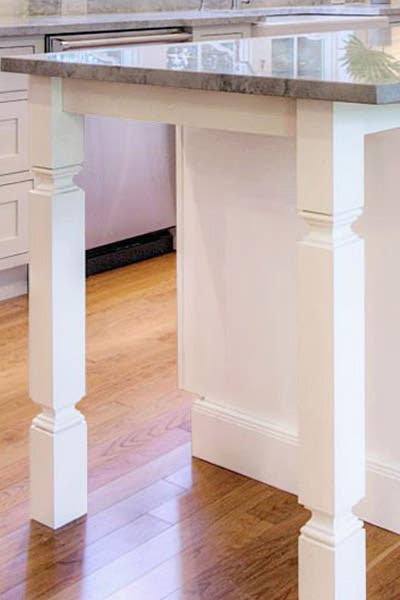Crucial Variables to Take Into Consideration When Choosing Legs For Kitchen Area Island
Picking the proper legs for a kitchen area island entails a cautious analysis of multiple aspects that can significantly affect both functionality and aesthetic allure. As we explore these aspects, it comes to be clear that each decision can have significant effects for the general cooking area experience.
Material Options
When choosing legs for a cooking area island, understanding the different product options is vital for attaining both aesthetic appeal and architectural honesty (Legs For Kitchen Island). The choice of material substantially affects not just the durability of the island however likewise its total layout and functionality
Wood is a prominent option, supplying heat and versatility. Solid hardwoods, such as oak or maple, offer stamina and can be discolored or repainted to match the cooking area decor. Metal legs, frequently made from stainless steel or wrought iron, contribute a contemporary and commercial feel while making sure longevity and security. These products are immune to use and can support considerable weight, making them suitable for bigger islands.
An additional alternative is crafted materials, like MDF or plywood, which can be more cost-effective while still offering a series of coatings. Nevertheless, they may not provide the very same degree of stability as strong timber or metal. Products such as acrylic or glass can produce a contemporary appearance, though they may call for extra support to make certain stability.
Ultimately, the option of material for cooking area island legs must align with the wanted functionality and the total style of the kitchen.
Design And Style

When considering style, the shape and finish of the legs are vital. Tapered legs can offer a sense of lightness and beauty, while thicker, much more robust legs can convey strength and stability. Additionally, the coating-- be it repainted, tarnished, or all-natural-- must match the cabinets and counter top materials to create a unified appearance.
In addition, the layout of the legs can likewise show personal taste. Personalized or attractive legs, such as those including elaborate carvings or unique geometric forms, can act as prime focus, adding personality and character to the kitchen area. Ultimately, the appropriate selection will not only boost performance but additionally raise the aesthetic allure, making the cooking area island a standout function of the home.
Elevation Factors To Consider
Selecting the appropriate elevation for kitchen area island legs is crucial, as it straight affects both functionality and convenience. The common height for a cooking area island normally ranges from 36 to 42 inches, straightening with typical kitchen counter heights. A 36-inch elevation is suitable for food preparation and food preparation, allowing for comfy use cooking area home appliances and devices. On the other hand, an elevation of 42 inches is typically favored for islands meant for bar seats, accommodating taller feceses and offering an informal dining experience.

It is likewise important to account for customers' elevations and preferences. Tailoring the elevation can ensure a comfy experience for all family participants, making the kitchen area island a more functional and satisfying space.
Weight Assistance
Guaranteeing adequate weight assistance for kitchen island legs is crucial for both safety and capability. The kitchen island usually serves numerous purposes, consisting of cooking, dining, and added storage, demanding a robust support framework. When selecting legs, it is critical to consider the general weight capacity needed based upon the island's intended use and the products that will certainly be placed on it.
The selection of product for the legs plays a considerable function in their weight-bearing capacities. Solid wood, steel, and heavy-duty composites normally give exceptional stamina contrasted to lighter products. Additionally, the style of the legs-- whether they are right, tapered, or have a pedestal kind-- can influence their capability to disperse weight properly throughout the structure.
Always consult the maker's specs relating to load limitations to make sure that the legs can sustain the designated weight without jeopardizing safety. In summary, picking cooking area island legs with ample weight assistance browse around here is crucial for creating a useful and risk-free culinary room.
Installment and Upkeep
Correct setup and upkeep of kitchen area island legs are critical for making certain longevity and security. This frequently entails securing the legs to the island base making use of suitable bolts, ensuring that the legs are degree and straightened.
When mounted, regular upkeep is necessary to protect the honesty and appearance of the legs - Legs For Kitchen Island. For wooden legs, routine cleaning with a moist towel and application of suitable wood gloss can prevent wetness damages and maintain their finish. Steel legs might require a gentle cleansing remedy to remove grease and crud, followed by a dry fabric to stop rust formation
In addition, inspect the legs frequently for indications of wear or damages, such as splits or loosened joints. Tightening up screws or screws as required can additionally lengthen the life-span of the legs. By sticking to these installment and upkeep techniques, home owners can make certain that their cooking area island continues to be tough Look At This and aesthetically appealing for several years ahead.
Verdict

Visual comprehensibility is extremely important in choosing the style and style of legs for a cooking area island, as these elements considerably influence the general atmosphere of the room. Conical legs can provide a sense of lightness and beauty, while thicker, much more durable legs can communicate toughness and security.Picking the ideal elevation for cooking area island legs is crucial, as it directly impacts both functionality and comfort. In summary, selecting kitchen island find legs with adequate weight assistance is vital for developing a secure and useful culinary area.
In final thought, selecting legs for a kitchen island necessitates careful factor to consider of numerous aspects, consisting of material options, style, elevation, weight assistance, and installation.